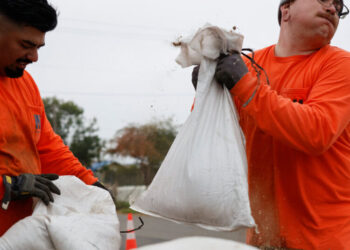High-concept shows easily go off the rails. “Westworld” sank under the weight of its own twists. “Game of Thrones” may have been fantasy, but it concluded with a decidedly pedestrian thud. Even “Severance,” despite the many pleasures of its second season, has so many plates spinning in the air that it seems unlikely to land them all safely; one misses the debut season’s assured tone and steady control.
“Stranger Things,” which will unveil Volume 1 of its final season this week, did not scream “high-concept” when it debuted in 2016. The show, which Duffer brothers Matt and Ross envisioned as a combo of Steven Spielberg and Stephen King, was schlocky, scary, nostalgic and joyously hyper-referential. Originality was neither a priority nor a concern; the show’s first season was a tasty but highly processed lasagna of ’80s tropes. You had “The Goonies” gang of kids coming of age through dangerous adventures, the high-schoolers navigating “Nightmare on Elm Street” horror (and sex), and the grown-ups dodging government agents and uncovering shady conspiracies. Then, of course, there were the monsters. There was a little “Poltergeist” in there. Some Wes Craven. More than a little “Alien,” which debuted in 1979.
These aren’t gotchas. “Stranger Things” has always winked at its influences — and its flaws. Way back in the second season, when Lucas (Caleb McLaughlin) tried to tell Max (Sadie Sink) the story of his friend Will’s (Noah Schnapp) disappearance, she called his story “a little derivative in parts.” A newcomer to the eldritch horrors plaguing Hawkins, Indiana, where the show is set, Max was calling Lucas not just a liar but a bad one regurgitating tired clichés. The burn came at the expense of the show itself.
Rarely has a show so exuberantly validated its critics while weakening the impact of the critique.
Whether it can sustain that charming insouciance throughout its final stretch remains an open question. Having seen four of the final season’s nine episodes, I can attest that there’s a lot of gratifying new material, particularly for fellow fans of author Madeleine L’Engle and Schnapp, and one very weird subplot. But the flashbacks are what interest me most; they feel anxious. There’s an urgency to them, a workmanlike sense of rigor that feels slightly at odds with the show’s mission and tone. Put simply: It feels, suddenly, like “Stranger Things” wants to explain itself. It wants to provide answers — and connections — that I both long for and fear the show can’t plausibly deliver. This series took pleasure in its own silliness; it didn’t always want to make sense. Now it does, and some of the suspense of this season lies in whether it can pull that off.
The much-anticipated fifth season opens swiftly and unusually, with Hawkins already in crisis. Vecna (a.k.a “One,” a.k.a. Henry Creel, all played by Jamie Campbell Bower), the villain and Eleven’s (Millie Bobby Brown) nemesis, may have retreated, but opening the fourth gate allowed some of the Upside Down — in particular, those floating dust particles — into the real world. The town is therefore in quarantine while the government studies the effects of that exposure on the residents. Eleven spends her days avoiding the military and training for an eventual encounter with Vecna under the supervision of Hopper (David Harbour) and Joyce (Winona Ryder), who are finally together.
Despite some flashes of normalcy — including an amusing scene which reveals that the Byerses are sheltering with the Wheelers — no one is really okay. Joyce remains unwilling to let Will take risks. Meanwhile, Lucas spends his days by Max’s hospital bed. Dustin, still grieving Eddie Munson (Joseph Quinn), trolls the jocks who wanted to kill him and snipes at Steve (Joe Keery).
Tactically, however, the ragtag group of amateurs has matured and professionalized, with different factions working toward well-defined objectives as they trawl the Upside Down for Vecna while evading government detection. Robin (Maya Hawke), now working as a radio DJ, delivers information about planned military operations in code. Murray (Brett Gelman) smuggles in whatever they need. Nancy defines areas to search. Hopper executes. But after 37 fruitless “crawls” systematically searching the Upside Down, they’re losing enthusiasm and hope. If these characters started the series playing, now they’re dutifully doing homework.
When “Stranger Things” began, I found it competent enough as a nostalgia piece but too messy to invest in long-term. The Upside Down, in particular, seemed underthought; the Demogorgon’s bestial predation squared oddly with the squelchy, botanical tubes and tendrils that incapacitated Will. Their connection to each other, and to the electricity, and to the evil scientists above, seemed tricky to plausibly explain. Throw in Russians and viruses and MKUltra and there was just a lot in there that wasn’t going to come together (or so I thought).
Nor did it seem like the show’s creators cared much about that aspect of things. The horror felt ambient. The “Stranger Things” approach to plot and lore was capacious and bubbly and irresponsible in ways that reminded me of my own pretend play as an ’80s kid (after reading Lois Lowry’s “Number the Stars,” my best friend and I spent many a glorious afternoon on the swing set — our ship — fleeing the Nazi pirates). The series operated according to a childlike, openhearted principle of accretion and excess, welcoming genres in and shrugging off any worries about their eventual incoherence or incompatibility. What if you combined “Stand By Me” with “The Karate Kid,” “Star Wars” and “E.T.”? Why not throw in some John Carpenter and John Hughes on a scaffolding of “Lord of the Rings” while deploying Dungeons and Dragons as your framing device!
Sure! That sounds fun. No one is going to worry too much about whether the mix can be sustained over 10 freaking years.
I’ve been surprised and impressed by how well the show has, in fact, sustained itself, despite all those moving parts. Like the Mind Flayer, which psychically and then materially subsumed people into a hive it controlled, the show has just kept absorbing stuff, assimilating genres and formulas and getting more powerful. In Billy Hargrove (Dacre Montgomery), the series remixed the eroticism of “Dirty Dancing”-era Patrick Swayze with Michael Emerson’s journey in “The Lost Boys” with the demonic possession of “The Exorcist” and Jack Nicholson’s arc in “The Shining.” The show folded in the Satanic Panic, ’80s mall culture, “The NeverEnding Story,” video stores, “Gremlins,” Cold War Russophobia, “Heathers,” and music — so much music. It understands and wisely deploys Spielbergian sentimentality. It sometimes improves on John Hughes dramas. It even pulled off a “The Great Escape” remixed with “Jurassic Park” and “Gladiator.”
Most shows would lose themselves under all that cultural baggage, but “Stranger Things” (mostly) didn’t. Its world and characters and overall identity remain miraculously stable and robust, given how much the child actors of 2016 have changed over the course of a decade. Sure, some characters ended up delivering exposition pellets while others languished in forgotten arcs, but it could all be quite a bit worse.
And the references didn’t just stay references. They leaked into the show, in a very pleasing way. Ryder, the show’s crown jewel, was of course an ’80s icon. So was Matthew Modine, who played Dr. Martin Brenner, the sinister researcher who experimented on superpowered children including Eleven. But the show added other avatars of ’80s pop culture including Sean Astin, Paul Reiser, Cary Elwes and Robert Englund.
The fifth season does not disappoint on this front: Linda Hamilton (Sarah Connor in the “Terminator” franchise) joins the cast as Dr. Kay, a high-ranking scientist for the military who makes Dr. Brenner look downright cuddly by comparison.
Until now, the slippage between the villains has felt like a concession to the show’s heterodox approach. You can do a “Nightmare on Elm Street” season after doing a hive mind season, but those require different monsters with different projects. Dustin’s suggestion in the fourth season that Vecna might be the Mind Flayer’s “five-star general” worried me. Those are very different flavors of horror! Equally worrying was the theory, floated elsewhere in the season, that Vecna controlled the Mind Flayer. Wrangling Henry’s specialty — precisely calibrated psychological torment — into any kind of hierarchical relationship with the Mind Flayer, which indiscriminately turns humans to goo, seems hard to pull off. In moving from the Demogorgon to the demodogs to the Mind Flayer to Henry, the show has gone from mute and viscerally horrifying to almost parodically verbal and convoluted.
For a series that has thrived for so long on vibes, hybridity and generative imprecision, getting too granular feels like a trap. The show risks slipping out of lowbrow fun into something more like high-concept ambition, and I’m not sure it can deliver.
But maybe this silly, warm, gory, surprising show will produce something genuinely original: a supernatural ecosystem capacious enough for all those different forms of evil to coherently coexist. Who knows? Stranger things have happened.
Strangers Things, Season 5, episodes 1-4 stream Nov. 26, episodes 5-7 stream Dec. 25, with the finale airing Dec. 31 on Netflix.
The post ‘Stranger Things’ goes high-concept in its grisly final season appeared first on Washington Post.




